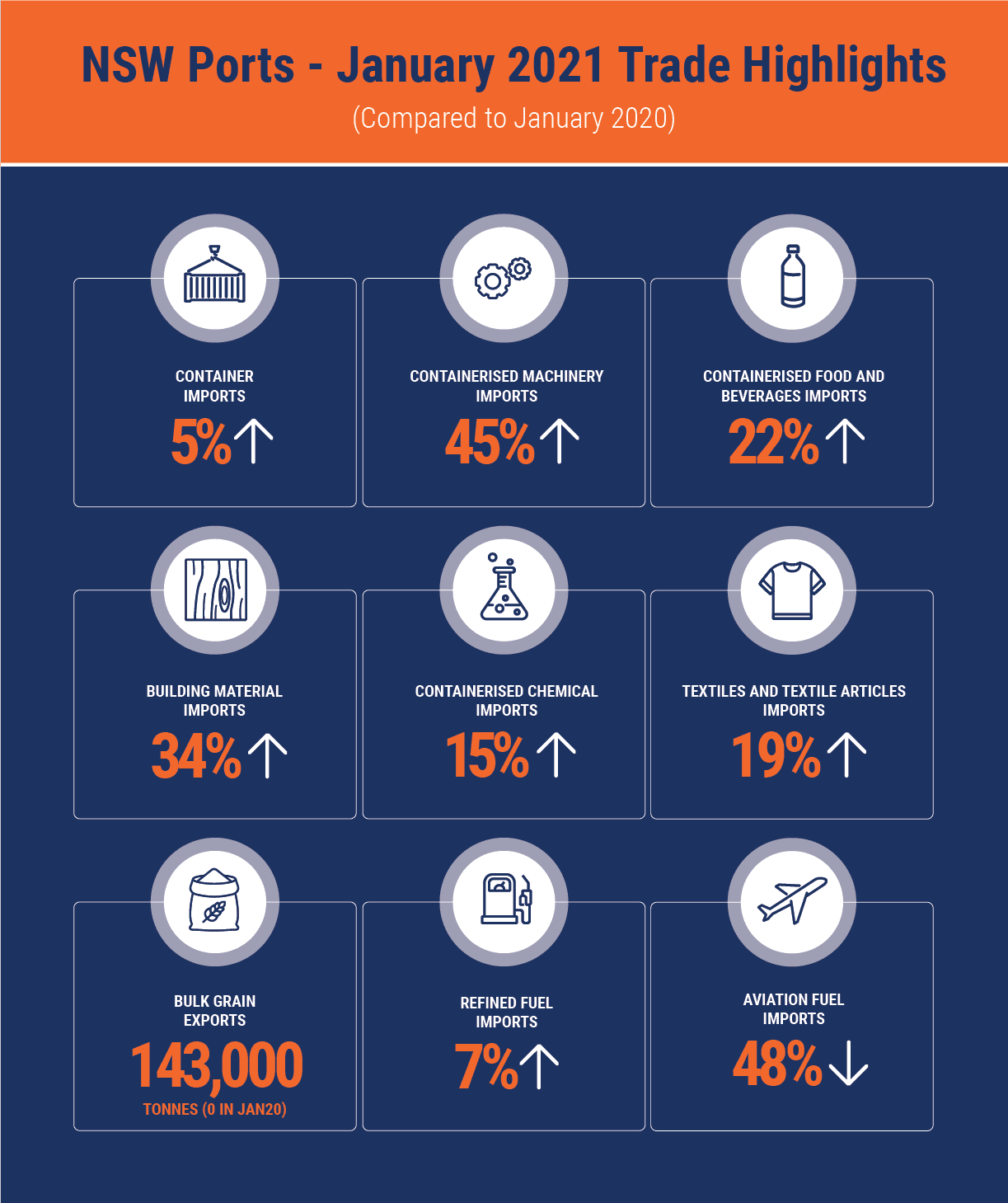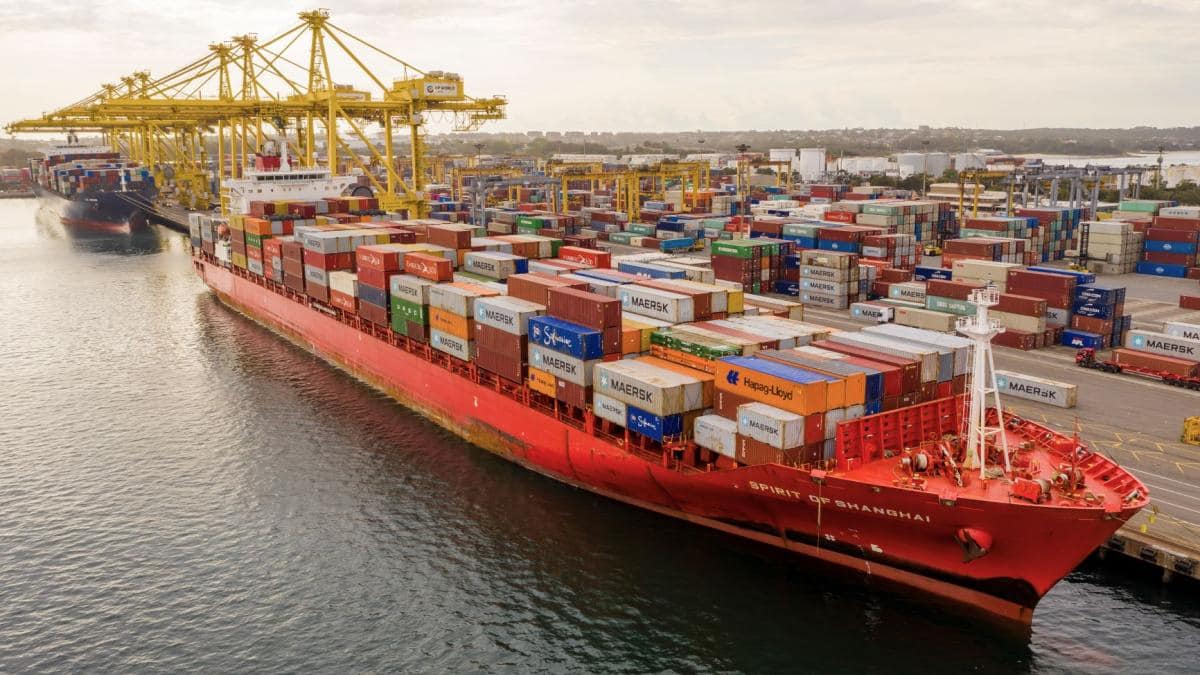NSW Ports CEO Marika Calfas provides an update on container supply chain congestion and operations at Port Botany and Port Kembla.
It’s now been a year since we first witnessed the onset of COVID-19 and its disruption of global supply chains. Throughout it all, port operators, port managers, government and industry have worked together to face the uncertainty of the pandemic and to keep our port supply chains moving. Port Botany and Port Kembla have continued to demonstrate their role as essential services in supporting the people and businesses of NSW.
Port Trades - An Economic Indicator
Many of the trades we handle at our ports provide a direct reflection on what's happening in the NSW economy including containers, fuel, motor vehicles and cement:
- Containers - while there was an initial decrease in container imports at the start of the pandemic, we have seen strong container volumes in recent months, with December 2020 and January 2021 delivering the highest container volumes on record at Port Botany. These increases are being fuelled by pandemic buying - with Australian consumers spending money on home renovations and personal shopping rather than on travel and experiences.
- Fuel volumes – unleaded and jet fuel dropped at the start of the pandemic, whilst diesel volumes grew due to increased agricultural and freight activities. Unleaded fuel volumes have returned to more typical levels as people have shifted from public transport into private vehicles and have been travelling locally for holidays.
- Cement Clinker imports - volumes have remained strong throughout COVID-19 in support of Sydney’s busy construction activities.
- Cars - there has been a recent increase in motor vehicle imports through Port Kembla, primarily due to government stimulus measures and changes in commuter travel as Australians return to office working.
Global Supply Chain Disruptions
That said, container trade continues to be impacted by disruptions within the global supply chain. High volumes of demand for goods globally, together with COVID-19 impacts on labour availability, have resulted in ships operating at or near capacity; a backlog of containers waiting to be exported out of China; and congestion at many ports around the world including the USA, Europe, Asia and New Zealand. This has created delays for vessels and the delivery of goods. International ports are now reporting delays ranging from several weeks to up to a month.
By comparison, Australian ports are currently operating well.
Port Botany Operations
Vessel Calls
Reflecting the improved berth availability at the port, there were 92 vessel calls in January, similar in number to the 91 calls in January 2020. However there has been a significant increase in the number of larger vessel calls – with 21 vessels >6,000 TEU capacity compared to 14 vessels in January 2020.
Servicing vessels arriving off-schedule
Vessels continue to arrive at Port Botany off-schedule due to delays at other ports. At DP World Australia’s (DPW) Sydney terminal, vessels arriving off-window are being serviced close to their time of arrival. Patrick Terminals - Sydney AutoStrad is experiencing delays of a few days for off-window vessels. Hutchison Ports Australia (Hutchison) is prioritising vessels arriving in window at its Sydney terminal. Some off-window vessels have been able to be serviced on arrival (where a berth is available) otherwise vessels are having to slow down until a berth is available, with delays of a few days. Ultimately, while Port Botany is well positioned to handle the volume of containers, it will be some time before global shipping schedules return to normal.
Containers at the Port
A number of ports around the world have a build up of containers at their terminals, causing congestion and a shortage of capacity to receive more containers. This is not the case at Port Botany where the average dwell time of an import container at the port in January was about 3 days.
Evacuation of containers
Managing the load to discharge ratio of a ship is an important factor to help avoid the build-up of empty containers in the container supply chain over time. There was some improvement in the evacuation of empty containers from Port Botany in December 2020, with a load / discharge ratio of 1.04. This means that there were more containers loaded and exported overseas than containers imported. This is a significant improvement from the 12-month average of 0.96, which has led to 78,000 TEU accumulating in Sydney. As of January, the ratio has dropped to 0.95. It’s important that import / export dynamics are managed to achieve a ratio close to 1 in order to maintain a balanced supply chain.
We also understand that both DP World and Hutchison are accepting shipping line requests to load more containers than their contracted volume and Patrick is accepting requests on a case-by-case basis. This is a delicate balancing act as it takes time to load more containers which may have a knock-on effect to subsequent vessels. Positively, this results in containers being exported out of Sydney, assisting in alleviating empty container build up.
Congestion surcharges
Whilst we understand that there continue to be disruptions to shipping lines, this is increasingly being driven by global shipping conditions, including high volume demand. We therefore remain concerned about the continued application of congestion surcharges by shipping lines specifically for Port Botany calls and we look forward to such charges being wound back.
Prioritising container exports
It’s great news for rural and regional Australia that we are experiencing a record harvest and availability of grain. We encourage shipping lines to continue to work with exporters to address the availability of containers for exports and to give appropriate priority to full container exports. It is critical that we support our exporters to ensure their long term viability through reliable and cost effective supply chains.
Working together with industry
Earlier this year, we worked with industry to address concerns regarding empty container park truck queuing at Port Botany. Together, we successfully implemented our Port Operator Directions requiring trucks to queue in dedicated locations. We appreciate industry’s cooperation and thank everyone involved for their support on this matter.
Port Kembla Trade
As an international trade gateway for bulk agricultural, construction and mining products, Port Kembla continues to demonstrate its role as a key trade gateway for the State.
In recent months, we have seen increased volumes of ‘project cargo’, as Port Kembla’s AAT terminal has specialised expertise in this field, including:
- Wind turbines for the Biala and Bango Wind Farms in NSW. When fully operational, these wind farms will produce enough electricity to power 146,000 homes.
- Several tunnel boring machines for the Snowy 2.0 hydroelectricity project.
- New trains for public transport. In total 554 new Intercity Fleet train carriages will be imported through the project and unloaded directly onto the Port’s rail infrastructure.
Port Kembla is now experiencing a resurgence in bulk grain exports after two years of extended drought. We continue to diversify the trades handled at Port Kembla and are progressing plans with Australian Industrial Energy for Australia’s first LNG import gas terminal project. Looking to the future, Port Kembla is identified by the NSW Government as NSW’s next container terminal, once Port Botany nears capacity.
NSW Ports January 2021 Trade Highlights


